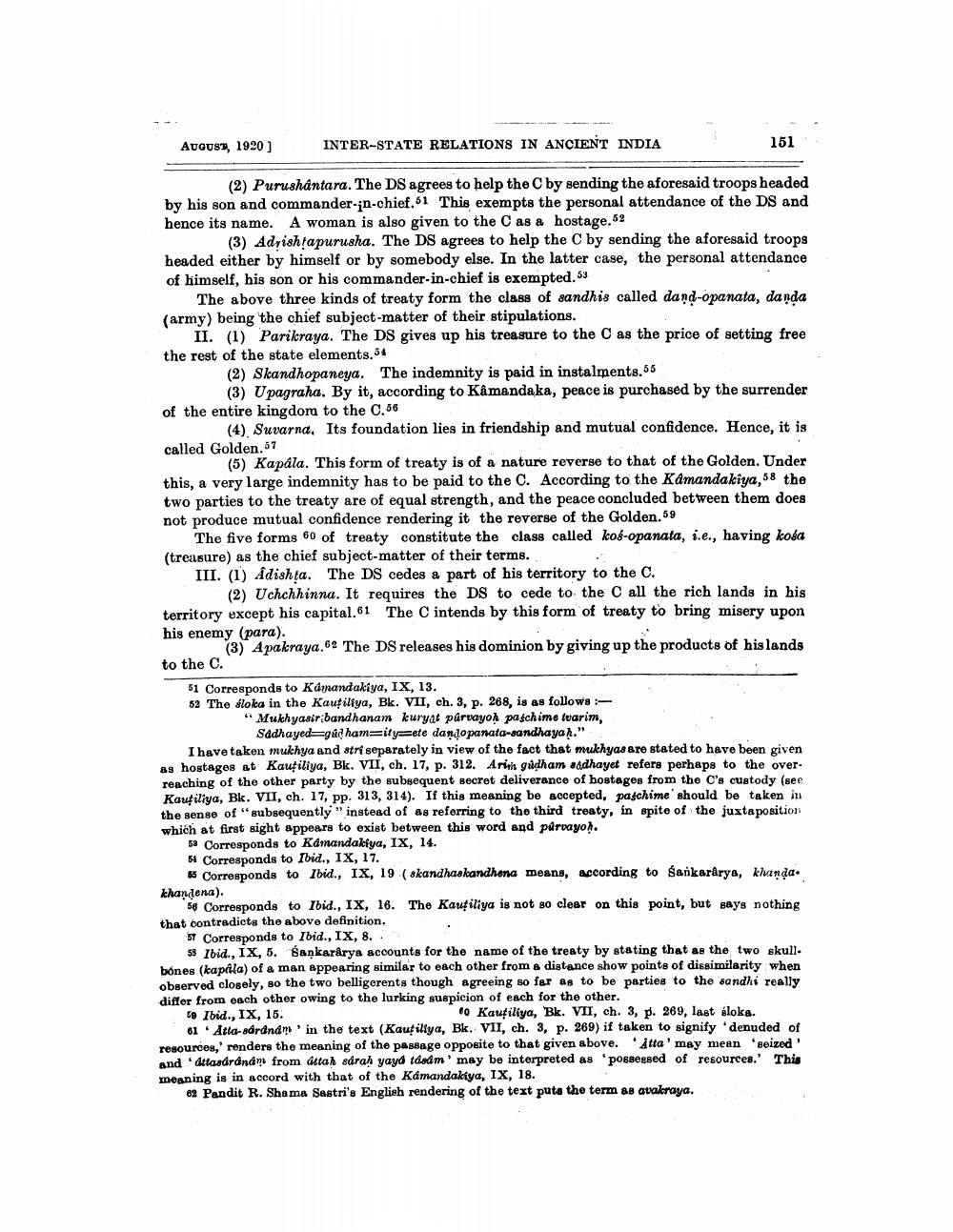________________
Auguss, 1920 )
INTER-STATE RELATIONS IN ANCIENT INDIA
151.
(2) Purushantara. The DS agrees to help the C by sending the aforesaid troops headed by his son and commander-in-chief.51 This exempts the personal attendance of the DS and hence its name. A woman is also given to the C as a hostage.62
(3) Adyishtapurusha. The DS agrees to help the C by sending the aforesaid troops headed either by himself or by somebody else. In the latter case, the personal attendance of himself, his son or his commander-in-chief is exempted.53
The above three kinds of treaty form the class of sandhis called dand-opanata, danda (army) being the chief subject matter of their stipulations.
II. (1) Parikraya. The DS gives up his treasure to the C as the price of setting free the rest of the state elements.54
(2) Skandhopaneya. The indemnity is paid in instalments.55
(3) Upagraha. By it, according to Kamandaka, peace is purchased by the surrender of the entire kingdom to the C. 56
(4) Suvarna. Its foundation lies in friendship and mutual confidence. Hence, it is called Golden 57
(5) Kapala. This form of treaty is of a nature reverse to that of the Golden. Under this, a very large indemnity has to be paid to the C. According to the Kamandakiya,58 the two parties to the treaty are of equal strength, and the peace concluded between them does not produce mutual confidence rendering it the reverse of the Golden.59
The five forms 60 of treaty constitute the class called kos-opanata, i.e., having koka (treasure) as the chief subject matter of their terms. III. (1) Adishta. The DS cedes a part of his territory to the C.
(2) Uchchhinna. It requires the DS to cede to the C all the rich lands in his territory except his capital.61 The C intends by this form of treaty to bring misery upon his enemy (para).
(3) Apakraya.62 The DS releases his dominion by giving up the products of his lands to the C.
61 Corresponds to Kamandakiya, IX, 13. 52 The sloka in the Kaufiliya, Bk. VII, ch. 3, p. 268, is as follows:
"Mukhyasir bandhanam kuryat púrvayok paschime tvarim,
Sadhayed=gadham=ity=ete dando panata-sandhaya." I have taken mukhya and stri separately in view of the fact that mukhyas are stated to have been given as hostages at Kaufiliya, Bk. VII, ch, 17, p. 312. Ari gadham aadhayet refers perhaps to the over. renching of the other party by the subsequent secret deliverance of hostages from the C's custody (see Kautiliya, Bk. VII, ch. 17, pp. 313, 314). If this meaning be sccepted, pagchime should be taken in the sense of "subsequently " instead of as referring to the third treaty, in spite of the juxtaposition which at first sight appears to exist between this word and purvayol.
50 Corresponds to Kamandakiya, IX, 14. 51 Corresponds to Ibid., IX, 17.
Corresponds to Ibid., IX, 19 ( skandhaskandhena means, according to sankardrya, khanda. khandena).
58 Corresponds to Ibid., IX, 16. The Kaufiliya is not so clear on this point, but says nothing that contradicts the above definition.
57 Corresponds to Ibid., IX, 8.
$3 Ibid., ix, 5. sankarkrya accounts for the name of the treaty by stating that as the two skull. bones (kapala) of a man appearing similar to each other from a distance show points of dissimilarity when observed closely, so the two belligerents though agreeing so far as to be parties to the sandhi really differ from each other owing to the lurking suspicion of each for the other. L9 Ibid., IX, 15.
0 Kautiliya, Bk. VII, ch. 3, p. 269, last sloka. 61. Atla-adrdndm in the text (Kaufiltya, Bk. VII, ch. 3, p. 269) if taken to signify denuded of resouroen,' renders the meaning of the passage opposite to that given above. Atta' may mean seized and dttasdrándni from dital sdrah yayd toedm may be interpreted as possessed of resources.' This meaning is in accord with that of the Kamandakiya, IX, 18.
62 Pandit R. Shama Sastri's English rendering of the text puts the term as avaloraya.




